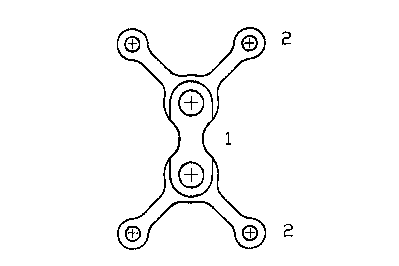Some of the information on this Web page has been provided by external sources. The Government of Canada is not responsible for the accuracy, reliability or currency of the information supplied by external sources. Users wishing to rely upon this information should consult directly with the source of the information. Content provided by external sources is not subject to official languages, privacy and accessibility requirements.
Any discrepancies in the text and image of the Claims and Abstract are due to differing posting times. Text of the Claims and Abstract are posted:
| (12) Patent: | (11) CA 2298420 |
|---|---|
| (54) English Title: | PRODUCTION PROCESS OF VARYING THICKNESS OSTEOSYNTHESIS PLATES |
| (54) French Title: | PROCESSUS DE FABRICATION DE PLAQUES D'EPAISSEURS VARIABLES, DESTINEES A L'OSTEOSYNTHESE |
| Status: | Expired and beyond the Period of Reversal |
| (51) International Patent Classification (IPC): |
|
|---|---|
| (72) Inventors : |
|
| (73) Owners : |
|
| (71) Applicants : |
|
| (74) Agent: | |
| (74) Associate agent: | |
| (45) Issued: | 2004-01-20 |
| (86) PCT Filing Date: | 1997-09-01 |
| (87) Open to Public Inspection: | 1998-03-12 |
| Examination requested: | 2000-02-17 |
| Availability of licence: | Yes |
| Dedicated to the Public: | N/A |
| (25) Language of filing: | English |
| Patent Cooperation Treaty (PCT): | Yes |
|---|---|
| (86) PCT Filing Number: | PCT/IT1997/000217 |
| (87) International Publication Number: | WO 1998009578 |
| (85) National Entry: | 1999-03-01 |
| (30) Application Priority Data: | ||||||
|---|---|---|---|---|---|---|
|
The invention concerns a process for the production
of osteosynthesis plates with a varying thickness thin
to whatever degree. The plates are manufactured by a
metal cutting process carried out on a composite structure
made by a layer of the material which will form the
osteosynthesis plate, bound through a layer of adhesive
to a supporting layer with high thermal conductivity and
mechanical strength. When the cutting process terminates,
the osteosynthesis plate is separated from the supporting
layer by heating the composite structure until the adhesive
melts or by using a thinner suitable for the adopted
adhesive.
L'invention se rapporte à un processus de fabrication de plaques destinées à l'ostéosynthèse, dont l'épaisseur peut être extrêmement fine. Ces plaques sont fabriquées par découpage d'un métal. Ce découpage est effectué sur une structure composite constituée d'une couche du matériau qui formera la plaque destinée à l'ostéosynthèse. Ladite couche est fixée par une couche d'adhésif à une couche de support à conductivité thermique et résistance mécanique élevées. Lorsque le découpage est achevé, la plaque destinée à l'ostéosynthèse est séparée de la couche de support par chauffage de la structure composite jusqu'à ce que l'adhésif fonde ou par utilisation d'un diluant agissant sur l'adhésif choisi.
Note: Claims are shown in the official language in which they were submitted.
Note: Descriptions are shown in the official language in which they were submitted.

2024-08-01:As part of the Next Generation Patents (NGP) transition, the Canadian Patents Database (CPD) now contains a more detailed Event History, which replicates the Event Log of our new back-office solution.
Please note that "Inactive:" events refers to events no longer in use in our new back-office solution.
For a clearer understanding of the status of the application/patent presented on this page, the site Disclaimer , as well as the definitions for Patent , Event History , Maintenance Fee and Payment History should be consulted.
| Description | Date |
|---|---|
| Time Limit for Reversal Expired | 2016-09-01 |
| Letter Sent | 2015-09-01 |
| Maintenance Request Received | 2014-08-29 |
| Maintenance Request Received | 2013-08-26 |
| Grant by Issuance | 2004-01-20 |
| Inactive: Cover page published | 2004-01-19 |
| Publish Open to Licence Request | 2003-11-12 |
| Pre-grant | 2003-11-12 |
| Inactive: Final fee received | 2003-11-12 |
| Notice of Allowance is Issued | 2003-05-20 |
| Letter Sent | 2003-05-20 |
| Notice of Allowance is Issued | 2003-05-20 |
| Inactive: Approved for allowance (AFA) | 2003-04-28 |
| Amendment Received - Voluntary Amendment | 2003-02-25 |
| Inactive: S.30(2) Rules - Examiner requisition | 2002-09-10 |
| Inactive: Cover page published | 2000-03-28 |
| Inactive: First IPC assigned | 2000-03-27 |
| Letter Sent | 2000-03-10 |
| Inactive: Acknowledgment of national entry - RFE | 2000-03-10 |
| Application Received - PCT | 2000-03-09 |
| All Requirements for Examination Determined Compliant | 2000-02-17 |
| Request for Examination Requirements Determined Compliant | 2000-02-17 |
| All Requirements for Examination Determined Compliant | 1999-10-02 |
| Small Entity Declaration Determined Compliant | 1999-03-01 |
| Application Published (Open to Public Inspection) | 1998-03-12 |
There is no abandonment history.
The last payment was received on 2003-08-01
Note : If the full payment has not been received on or before the date indicated, a further fee may be required which may be one of the following
Please refer to the CIPO Patent Fees web page to see all current fee amounts.
Note: Records showing the ownership history in alphabetical order.
| Current Owners on Record |
|---|
| ANNA MAGRINI |
| Past Owners on Record |
|---|
| MAURIZIO CARTA |